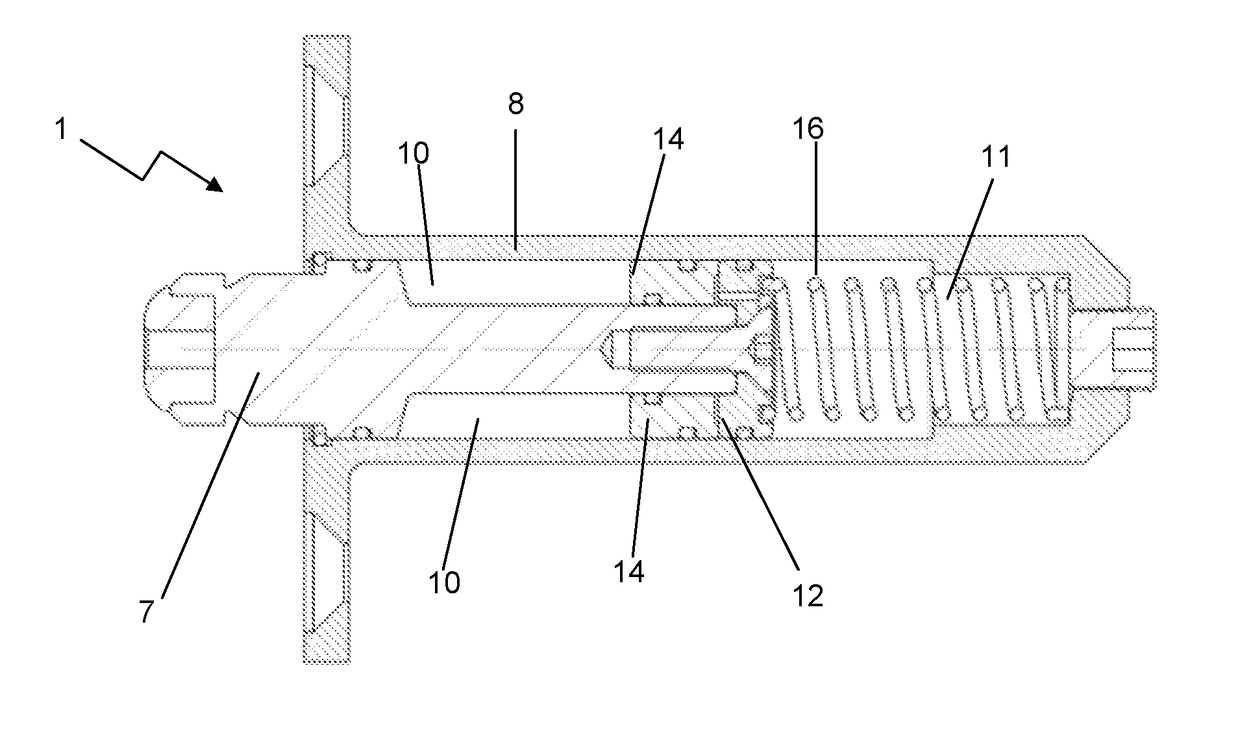Door Anti-slamming device
- Summary
- Abstract
- Description
- Claims
- Application Information
AI Technical Summary
Benefits of technology
Problems solved by technology
Method used
Image
Examples
example 1
[0176]FIGS. 2A and B illustrates the device according the Embodiment 1 of the present invention.
[0177]The device (1) includes a plunger (7) which is configured to slidably move in the chamber (8) which is also cylindrically shaped. The entrance (5) includes a stop (9). The tip (6) of the plunger (7) protrudes out of the entrance (5) by 18 mm.
[0178]The plunger (7) includes the second cavity (10) and biasing means configured as a spring loaded coil (11). The second cavity (10) is formed by the internal walls of the plunger (7), a partition (12) including the orifice (13), and a movable wall (14) which is engaged with the spring loaded coil (11). The plunger (7) and walls of the chamber (8) include O-rings (15) to effectively seal different parts of the device (1).
[0179]The chamber (8) includes a first cavity (16) which is expanded when the device is in the expanded configuration, as depicted in FIG. 2A. In this configuration, the second cavity (10) is contracted. Moving to FIG. 2B, th...
example 2
[0182]FIGS. 5A and B illustrate the device according the Embodiment 2 of the present invention in an expanded configuration and compacted configuration, respectively.
[0183]In Embodiment 2, the second cavity (10) is formed from an interworking relationship between the plunger (7) configured as a centralized column, the inner walls of the chamber (8), the partition (12) including the orifice (13) and a movable wall (14) which slides about the centralized plunger (7) and against the inner walls of the chamber (8).
[0184]The biasing means (11) is in the first cavity (16) and is biased towards the first cavity (16) being expanded. The first cavity (16) is located in the peripheral portion of the chamber (8) distal to the entrance (5).
[0185]As the plunger (7) is forced into the chamber (8), the material (not shown) transfers through the orifice (13), driving back the movable wall (14) to expand the size of the second cavity (10) to accommodate the displaced material from the first cavity (...
example 3
[0186]FIGS. 6A and B illustrate the device according the Embodiment 3 of the present invention in an expanded configuration and compacted configuration, respectively.
[0187]In Embodiment 3, the partition (12) is a fixed wall integrally built into the chamber (8), with the partition (12) including the orifice (13) including a nozzle (20).
[0188]The second cavity (10) is located on the opposite side to the partition (12) and away from the entrance (5). The second cavity (10) is defined by the inner walls of the chamber (8), the partition (12) and a movable wall (14) biased towards the partition (12) by the spring loaded coil (11).
[0189]The first cavity (16) is located on the opposite side of the partition (12) to the second cavity (10) and nearer to the entrance (5), and is defined by the inner walls of the chamber (8), the partition (12) housing the orifice (13) and by the front surface (21) of the plunger (7).
[0190]The plunger (7) is a solid cylindrical component that drives into the ...
PUM
 Login to view more
Login to view more Abstract
Description
Claims
Application Information
 Login to view more
Login to view more - R&D Engineer
- R&D Manager
- IP Professional
- Industry Leading Data Capabilities
- Powerful AI technology
- Patent DNA Extraction
Browse by: Latest US Patents, China's latest patents, Technical Efficacy Thesaurus, Application Domain, Technology Topic.
© 2024 PatSnap. All rights reserved.Legal|Privacy policy|Modern Slavery Act Transparency Statement|Sitemap



